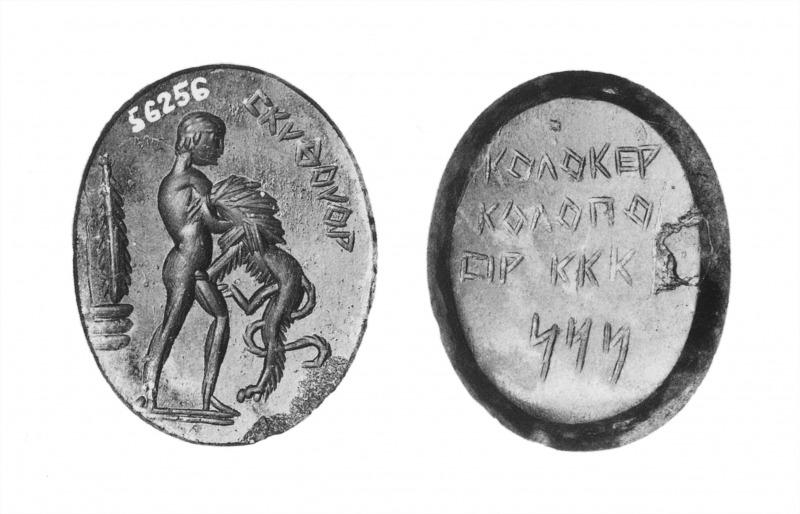Bonner, SMA, 63.
est; tritus autem emittit croceum colorer,”46 a description which would fit limonite, an iron ore nearly related to haematite; it is dark brown and gives a yellow streak when scratched. Pliny mentions Median zmaragdos, doubtless a green stone, but probably not emerald.47 The actual specimens bearing this design and shown by inscriptions to be magical are usually cut in red jasper (D. 108, 109, 110). This is another illustration of the discrepancy between the literary and the archaeological evidence relating to magical amulets. I have listed twelve specimens of the Herakles and lion type, all on red jasper; one on red carnelian; one on heliotrope, or green jasper flecked with red.48 Most of these stones have nothing to indicate their magical character except the three letters ΚΚΚ, to which the stonecutter sometimes adds other characters of uncertain import; but Lenormant published a specimen that leaves no doubt about its purpose.49 The usual design of Herakles with the lion is partly encircled by the inscription αναχωρι κολε το θιον σε διοκει (ἀναχώρει, κόλε, τὸ θεῖόν σε διώκει); in the exergue, ΚΚΚ and an eight-pointed star. On the reverse there is a figure of the triple Hecate, holding in her three pairs of hands torches, daggers, and whips.
As for the meaning of the three kappas, it was natural to seek an explanation in the initial letter of the word κωλικὴ (διάθεσις), the term for colic used by Alexander of Tralles (8, 2); the suggestion was first offered by Chiflet. Other explanations may be proposed, however. Two amulets bear inscriptions that may throw light upon the matter. A heliotrope belonging to the British Museum has on the obverse Herakles wrestling with the lion; behind him, a palm, above, the unintelligible σκυθουορ. On the reverse κολοκερ κολοπο σιρ, with ΚΚΚ, and below the kappas, IMG.50 This is no more intelligible than the word on the obverse, but it has three kappas in it; hence one may very well imagine this to be a secret magical name, and the kappas a mnemonic device to enable the wearer to remember the word of power. On the Copenhagen carnelian published by Eitrem there is an incomplete version of the same inscription partly encircling the obverse type, κερκολοφοσειρ; the first κολο was omitted, perhaps for want of room, and φ:π and ει:ι are mere orthographic variants.51
Another demonic name with kappas is to be found in a fever charm written on papyrus.52 First there is a long magical word, repeated with removal of initial and final letters until it is reduced to a single letter, the whole being in the form of an inverted pyramid. Then, ἀκάματε Κοκ Κουκ Κουλ is invoked to relieve Tais of every kind of fever. It is possible that this demon
46 De lapidibus 21 (ed. Abel). The work is thought to be of the second century of our era.
47 N. H. 37, 71.
48 B. M. 56224, 56364; Chabouillet 1762; Babelon, Guide, 2220 bis; Furtwängler, Beschreibung, 8477, 8478; Southesk N 58; Ravenna, Library, No. 10 (see Rev. arch., 1883, 1, p. 306); M. M. Cat. Gems, 386. To these may be added D. 108–110.
49 Rev. arch., 1846, 2, pp. 510 ff.
51 Copenhagen, National Museum, Inv. 1612; see Symb. Oslo., 19, 76 f.
52 PGM XXXIII, 19 (P. Tebt. 275).
Last modified: 2012-11-05 10:44:50
Link: cbd.mfab.hu/pandecta/1502





